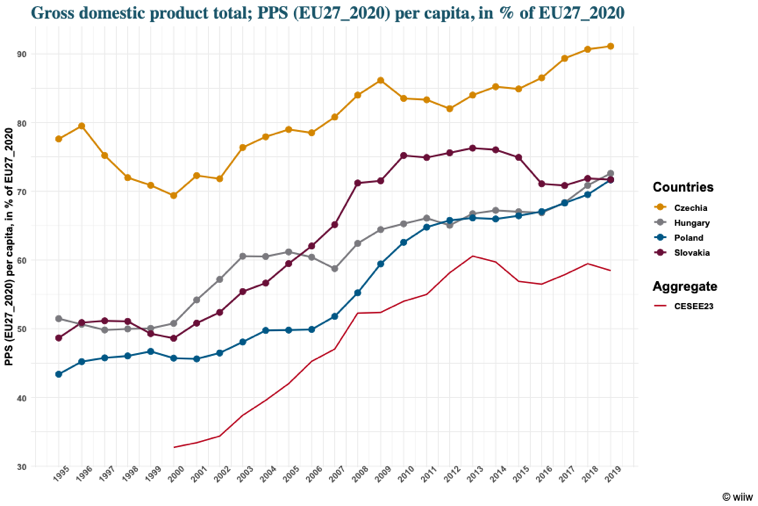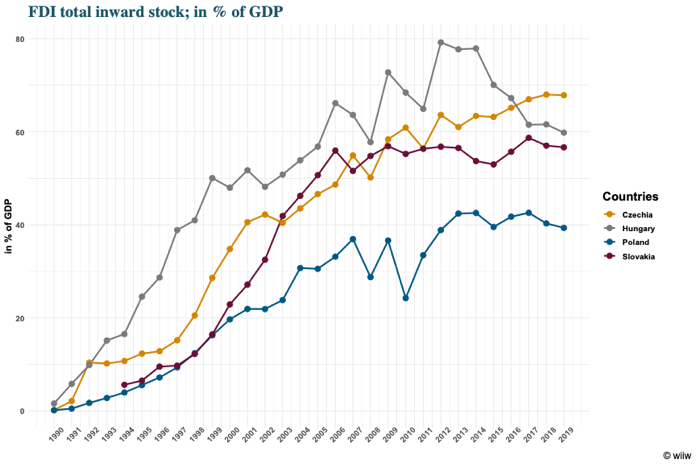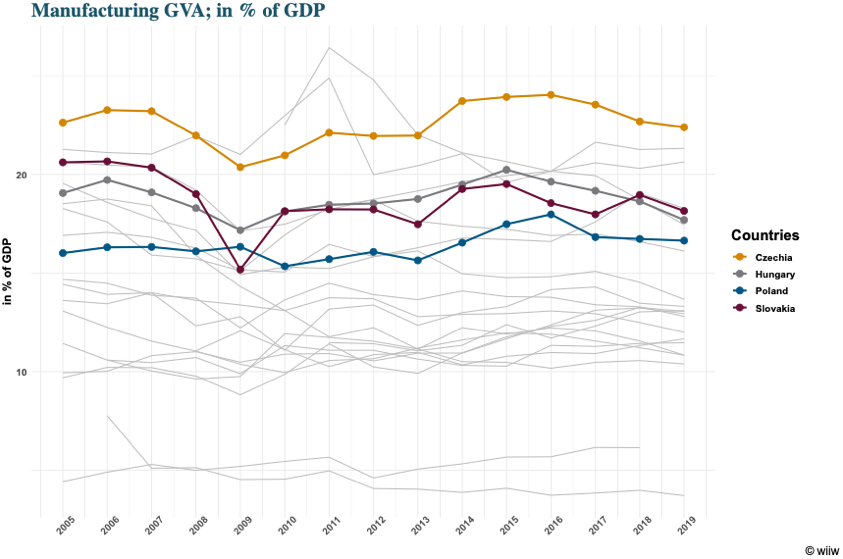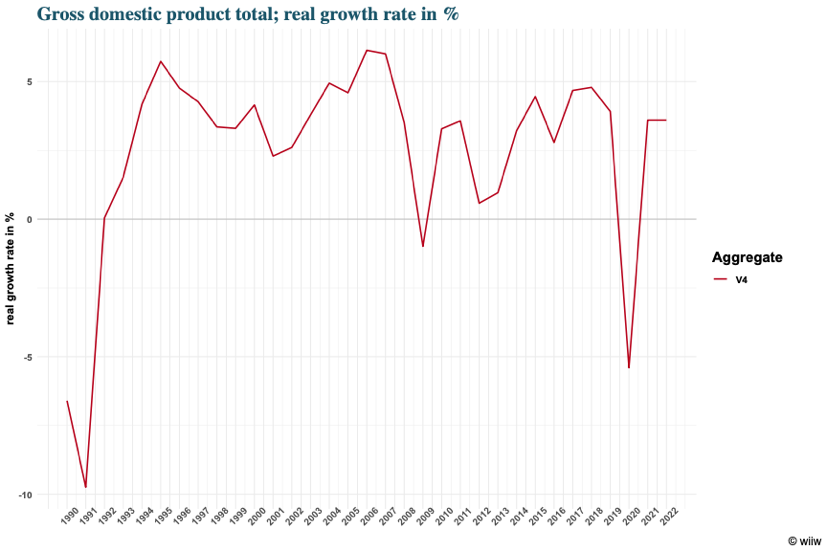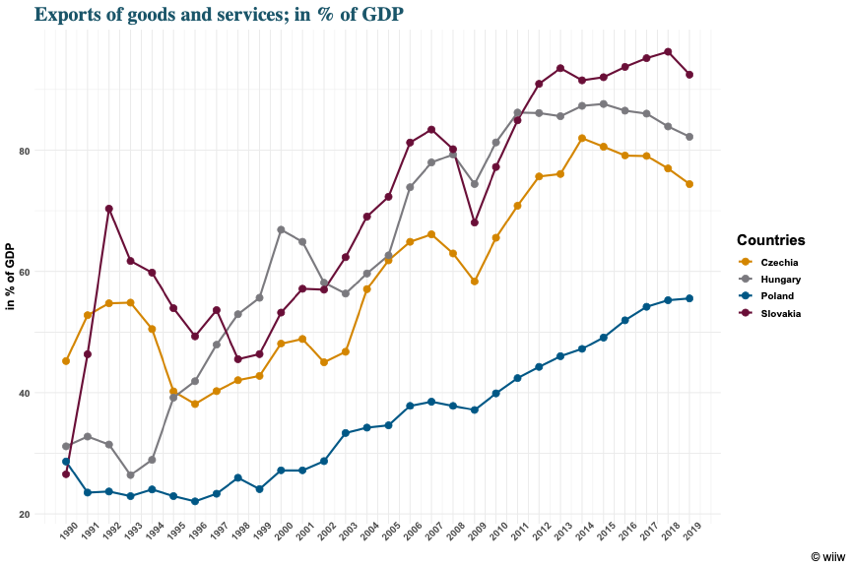On February 15th the Visegrád Agreement will be 30 years old. A thread summarising the region’s economic development over the last three decades and some of the current and future challenges it faces, including a few highlights from recent @wiiw_ac_at research. /1
Since the mid-1990s the four countries achieved economic convergence with Western Europe. All are wealthy by CESEE standards, and have developed a modern, sophisticated manufacturing sector, underpinned by an FDI- and export-driven growth model. /2
This model has helped return the Visegrád countries to the centre of the European economy, via integration with Germany and Austria as part of the Central European manufacturing core. /3 https://wiiw.ac.at/structural-change-and-global-value-chains-in-the-eu-p-3969.html
This industrial integration is only part of a wider story in the last 30 years; the strong (re)integration of the V4 and the rest of CEE with Germany + Austria via trade, migration and investment flows. /4 https://metropole.at/the-long-road-home/
The economies of Germany and Austria, including many of their biggest companies, have benefitted, driving an increasing convergence of economic interests between them and the Visegrád countries. /5 https://internationalepolitik.de/de/alle-einem-boot?_ga=2.142118514.1587344810.1612778353-1836162648.1586272197
However, as many of us know, life gets a bit more complicated after 30, and there will be challenges for the Visegrád countries in the coming years. /6
One broad issue is the V4 economic model itself; some argue that a reliance on FDI and exports have prevented quicker catch-up with Western Europe and that a much more fundamental re-think of the model is required. /7 https://wiiw.ac.at/development-patterns-of-central-and-east-european-countries-in-the-course-of-transition-and-following-eu-accession-p-2985.html
In a previous study, my colleague Roman Stoellinger found evidence of V4 over-specialisation in the production part of the value chain, and not enough in higher-value areas such as headquarter + R&D services./8 https://wiiw.ac.at/functional-specialisation-in-global-value-chains-and-the-middle-income-trap-p-5036.html
Further challenge is the shrinking of working-age populations, in common with most of CESEE. Pre-Covid the V4 was approaching a ‘tipping point’ where it would run out of workers. This has been delayed by the pandemic, but probably cannot be avoided. /9 https://wiiw.ac.at/eu-faces-a-tough-demographic-reckoning-p-4912.html
These labour shortages have created fears that foreign investors will leave because labour too expensive or too scarce. After decades of strong growth, FDI as share of GDP seems to have plateaued or even started to fall. /10
However, while FDI may not contribute a lot to growth in the future, it is unlikely that foreign investors will leave just because of negative demographic trends. The V4 still has plenty of advantages relative to other potential FDI destinations. /11 https://www.oenb.at/dam/jcr:02851c10-fcbb-4d1f-b056-5095d246e2dc/11_Demographic_decline_feei_2018_q3.pdf
Labour shortages pushed up wages, but there is little evidence that this eroding competitiveness. In the Central European manufacturing core (which includes all V4) productivity growth has outpaced that of wages for most of time since 2002. /12 https://wiiw.ac.at/decoupling-of-labour-productivity-growth-from-median-wage-growth-in-central-and-eastern-europe-dlp-5356.pdf
This links to another key challenge: a high reliance on manufacturing exports and especially the automotive sector at time of global trade tensions, supply chain disruptions and green transition (grey lines = all other CESEE countries). /13
After coping relatively well with first Covid wave, V4 countries have suffered much more from pandemic over winter. Collectively this is easily V4’s worst economic downturn since transition recessions of early 1990s and Poland’s first recession for almost three decades. /14
However, V4 have fiscal + monetary resources to react, bolstered by support from the EU. Over time V4 should benefit from digitalisation boost and near-shoring. /15 https://wiiw.ac.at/foreign-investments-hit-by-covid-19-pandemic-fdi-in-central-east-and-southeast-europe-p-5540.html
Although V4 acts collectively on many issues, post-2008 there have been clear differences, including on euro accession and relationship with Brussels. Differences in economic structure also create varying interests (eg PL less export-reliant). /16
In summary, V4 has plenty of strengths, but policy challenges (both pre-existing and due to Covid) are significant. Later today, @wiiw_ac_at will jointly host an event with @dgapev to look at these issues and the region’s future. /17 https://wiiw.ac.at/visegrad-4-at-30-economic-outlook-regional-dynamics-role-in-the-eu-e-501.html
Meanwhile in a forthcoming study with @FES_MOE we will take a deep dive into what comes next: has the region’s growth model run out of steam, and what could replace it? What about the challenges of the megatrends: climate crisis, demographics, digitalisation etc. /18
For a broader take, see our paper on CEE as a whole 30 years after the Berlin Wall. In the context of much of the rest of the region, the V4 has had a fairly prosperous, peaceful three decades. /19 https://wiiw.ac.at/looking-back-looking-forward-central-and-eastern-europe-30-years-after-the-fall-of-the-berlin-wall-p-5059.html
The data/charts in this thread were prepared by @alexbykova and @DavidZenz using our new CESEE visual data explorer here: /20 https://wiiw.ac.at/cesee-visual-data-explorer.html
Check back to our website for more on Visegrád during February, including our upcoming Monthly Report with a special focus on the four countries. /end https://wiiw.ac.at

 Read on Twitter
Read on Twitter